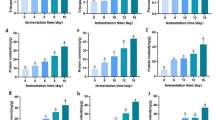Abstract
Clostridium thermocellum strains SS8 and GS1 grew poorly on crude blopolymers but termented them easily after alkall treatment. With 1% alkall-extracted rice straw (AERS) and dellgnified bamboo pulp (DBP), the ethanol-to-substrate (E/S) ratios were almost the same as those obtained when using fillter paper. Increasing the substrate concentrations decreased the percentage substrate degraded and the E/S ratio and concomitantly increased the amount of reducing sugars accumulated. A maximum amount of 8.6 g ethanol/l was produced by strain SS8 out of 37.5 g DBP degraded. Strain GS1 accumulated reducing sugars at substrate concentrations >50 g/l, thereby accounting for about 70% of AERS degraded. This strain produced cellulase on both cellulose and cellobiose. Both the strains grew in the presence of 1.5% (v/v) ethanol. Strain SS8 fermented starch, but the ethanol yield was low compared to that from cellulose. About 75% of starch degraded accumulated as reducing sugars at a substrate concentration of 40 g/l. The Inhibitory effects of ethanol (2 to 4%) were less drastic when growing cultures were challenged than when they were formed in situ. The effect of ethanol depended upon the phase of the culture.
Similar content being viewed by others
References
Bender, J., Vatcharapijarn, Y. & Jeffries, T.W. 1985 Characteristics and adaptability of some new isolates of Clostridium thermocellum. Applied and Environmental Microbiology 49, 475–477.
Dubois, M., Gilles, K.A., Hamilton, J.K., Rebers, P.A. & Smith, F. 1956 Colorimetric method for determination of sugars of related substances. Analytical Chemistry 28, 350–356.
Duong, T.V., Johnson, E.A. & Demain, A.L. 1983 Thermophilic anaerobic and cellulolytic bacteria. Topics in Enzyme Fermentation Biotechnology 7, 156–195.
Garcia-Martinez, D.V., Shinmyo, A., Madia, A. & Demain, A.L. 1980 Studies on cellulase production by Clostridium thermocellum. European Journal of Applied Microbiology and Biotechnology 9, 189–197.
Giuliano, C., Asther, M. & Khan, A.W. 1983 Comparative degradation of cellulose and sugar formation by three newly isolated mesophilic anaerobes and Clostridium thermocellum. Biotechnology Letters 5, 395–398.
Herrero, A.A. & Gomez, R.F. 1980 Development of ethanol tolerance in Clostrium thermocellum: Effect of growth temperature. Applied and Environmental Microbiology 40, 571–577.
Johnson, E.A., Bouchot, F. & Demain, A.L. 1985 Regulation of cellulase formation in Clostridium thermocellum. Journal of General Microbiology 131, 2303–2308.
Kundu, S., Ghose, T.K. & Mukhopadhyay, S.N. 1983 Bioconversion of cellulose into ethanol by Colstridium thermocellum-product inhibition. Biotechnology and Bioengineering 25, 1109–1125.
Lovitt, R.W., Kim, B.H., Shen, G.J. & Zeikus, J.G. 1988 Solvent production by microorganisms. CRC Critical Reviews in Biotechnology 7, 107–186.
Ng, T.K., Ben-Bassat, A. & Zeikus, J.G. 1981 Ethanol production by thermophilic bacteria: fermentation of cellulosic substrates by co-cultures of Clostridium thermocellum and Clostridium thermobydrosulfuricum. Applied and Environmental Microbiology 41, 1337–1343.
Ng, T.K., Weimer, P.J. & Zeikus, J.G. 1977 Cellulolytic and physiological properties of Clostridium thermocellum. Archives in Microbiology 114, 1–7.
Petre, J., Longin, R. & Millet, J. 1981 Purification and properties of an endo-β-1,4-glucanase from Clostridium thermocellum. Biochimie 63, 629–639.
Rogers, P. 1986 Genetics and biochemistry of Clostridium relevant to development of fermentation processes. Advances in Applied Microbiology 31, 1–60.
Saddler, J.N. & Chan, M.J.H. 1984 Conversion of pretreated lignocellulosic substrates to ethanol by Clostridium thermocellum in mono- and co-culture with Clostridium thermosaccharolyticum and Clostridium thermohydrosulfuricum. Canadian Journal of Microbiology 30, 212–220.
Sai Ram, M. & Seenayya, G. 1989 Ethanol production by Clostridium thermocellum SS8, a newly isolated thermophilic bacterium. Biotechnology Letters 11, 589–592.
Slapack, G.E., Russell, I. & Stewart, G.C. 1985 Thermophilic bacteria and thermotolerant yeasts for ethanol production. NRCC No. 24410. Project Report Submitted to Division of Energy, NRC, Ottawa, 404 pp.
Weiner, P.J. & Zeikus, J.G. 1977 Fermentation of cellulose and cellobiose by Clostridium thermocellum in the absence and presence of Methanobacterium thermoautotrophicum. Applied and Environmental Microbiology 33, 289–297.
Additional information
The authors are with the Department of Microbiology, Osmania University, Hyderabad-500007, India.
Rights and permissions
About this article
Cite this article
Sai Ram, M., Seenayya, G. Production of ethanol from straw and bamboo pulp by primary isolates of Clostridium thermocellum . World Journal of Microbiology and Biotechnology 7, 372–378 (1991). https://doi.org/10.1007/BF00329405
Revised:
Accepted:
Issue Date:
DOI: https://doi.org/10.1007/BF00329405




